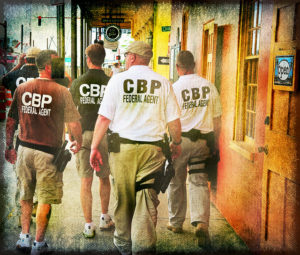The Federal Government Is Helping Police Nationwide Secretly Exploit Intrusive Technologies
Unfortunately, power loves the dark. Cali4beach / CC-BY-2.0
1
2
3
4
Cali4beach / CC-BY-2.0
1
2
3
4
If, for instance, the software depends on historical crime data from a racially biased police force, then it’s just going to send a flood of officers into the very same neighborhoods they’ve always over-policed. And if that happens, of course, more personnel will find more crime — and presto, you have the potential for a perfect feedback loop of prejudice, arrests, and high-tech “success.” To understand what that means, keep in mind that, without a computer in sight, nearly four times as many blacks as whites are arrested for marijuana possession, even though usage among the two groups is about the same.
If you leave aside issues of bias, there’s still a fundamental question to answer about the new technology: Does the software actually work or, for that matter, reduce crime? Of course, the companies peddling such products insist that it does, but no independent analyses or reviews had yet verified its effectiveness until last year — or so it seemed at first.
In December 2015, the Journal of the American Statistical Association published a study that brought joy to the predictive crime-fighting industry. The study’s researchers concluded that a predictive policing algorithm outperformed human analysts in indicating where crime would occur, which in turn led to real crime reductions after officers were dispatched to the flagged areas. Only one problem: five of the seven authors held PredPol stock, and two were co-founders of the company. On its website, PredPol identifies the research as a “UCLA study,” but only because PredPol co-founder Jeffery Brantingham is an anthropology professor there.
Predictive policing is a brand new area where question marks abound. Transparency should be vital in assessing this technology, but the companies generally won’t allow communities targeted by it to examine the code behind it. “We wanted a greater explanation for how this all worked, and we were told it was all proprietary,” Kim Harris, a spokeswoman for Bellingham, Washington’s Racial Justice Coalition, told the Marshall Project after the city purchased such software last August. “We haven’t been comforted by the process.”
The Bellingham Police Department, which bought predictive software made by Bair Analytics with a $21,200 Justice Department grant, didn’t need to go to the city council for approval and didn’t hold community meetings to discuss the development or explain how the software worked. Because the code is proprietary, the public is unable to independently verify that it doesn’t have serious problems.
Even if the data underlying most predictive policing software accurately anticipates where crime will indeed occur — and that’s a gigantic if — questions of fundamental fairness still arise. Innocent people living in or passing through identified high crime areas will have to deal with an increased police presence, which, given recent history, will likely mean more questioning or stopping and frisking — and arrests for things like marijuana possession for which more affluent citizens are rarely brought in. Moreover, the potential inequality of all this may only worsen as police departments bring online other new technologies like facial recognition.
We’re on the verge of “big data policing,” suggests law professor Andrew Ferguson, which will “turn any unknown suspect into a known suspect,” allowing an officer to “search for information that might justify reasonable suspicion” and lead to stop-and-frisk incidents and aggressive questioning. Just imagine having a decades-old criminal record and facing police armed with such powerful, invasive technology.
This could lead to “the tyranny of the algorithm” and a Faustian bargain in which the public increasingly forfeits its freedoms in certain areas out of fears for its safety. “The Soviet Union had remarkably little street crime when they were at their worst of their totalitarian, authoritarian controls,” MIT sociologist Gary Marx observed. “But, my god, at what price?”
To Record and Serve… Those in Blue
On a June night in 2013, Augustin Reynoso discovered that his bicycle had been stolen from a CVS in the Los Angeles suburb of Gardena. A store security guard called the police while Reynoso’s brother Ricardo Diaz Zeferino and two friends tried to find the missing bike in the neighborhood. When the police arrived, they promptly ordered his two friends to put their hands up. Zeferino ran over, protesting that the police had the wrong men. At that point, they told him to raise his hands, too. He then lowered and raised his hands as the police yelled at him. When he removed his baseball hat, lowered his hands, and began to raise them again, he was shot to death.
The police insisted that Zeferino’s actions were “threatening” and so their shooting justified. They had two videos of it taken by police car cameras — but refused to release them.
Although police departments nationwide have been fighting any spirit of new openness, car and body cameras have at least offered the promise of bringing new transparency to the actions of officers on the beat. That’s why the ACLU and many civil rights groups, as well as President Obama, have spoken out in favor of the technology’s potential to improve police-community relations — but only, of course, if the police are obliged to release videos in situations involving allegations of abuse. And many departments are fighting that fiercely.
In Chicago, for instance, the police notoriously opposed the release of dashcam video in the shooting death of Laquan McDonald, citing the supposed imperative of an “ongoing investigation.” After more than a year of such resistance, a judge finally ordered the video made public. Only then did the scandal of seeing Officer Jason Van Dyke unnecessarily pump 16 bullets into the 17-year-old’s body explode into national consciousness.
In Zeferino’s case, the police settled a lawsuit with his family for $4.7 million and yet continued to refuse to release the videos. It took two years before a judge finally ordered their release, allowing the public to see the shooting for itself.
Your support matters…Independent journalism is under threat and overshadowed by heavily funded mainstream media.
You can help level the playing field. Become a member.
Your tax-deductible contribution keeps us digging beneath the headlines to give you thought-provoking, investigative reporting and analysis that unearths what's really happening- without compromise.
Give today to support our courageous, independent journalists.





You need to be a supporter to comment.
There are currently no responses to this article.
Be the first to respond.